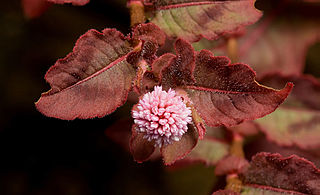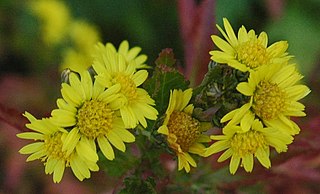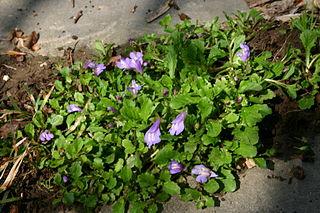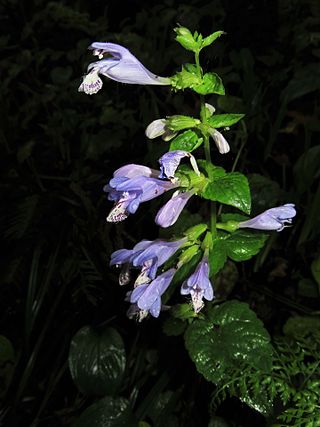
Honeysuckles are arching shrubs or twining vines in the genus Lonicera of the family Caprifoliaceae. It includes 158 species native to northern latitudes in North America, Eurasia, and North Africa. Widely known species include Lonicera periclymenum, Lonicera japonica and Lonicera sempervirens. L. japonica is a highly invasive species considered a significant pest in parts of North America, Europe, South America, Australia, and Africa.

Persicaria is a genus of herbaceous flowering plants in the knotweed family, Polygonaceae. Plants of the genus are known commonly as knotweeds or smartweeds. It has a cosmopolitan distribution, with species occurring nearly worldwide. The genus was segregated from Polygonum.

Chrysanthemums, sometimes called mums or chrysanths, are flowering plants of the genus Chrysanthemum in the family Asteraceae. They are native to East Asia and northeastern Europe. Most species originate from East Asia, and the center of diversity is in China. Countless horticultural varieties and cultivars exist.

Arisaema is a large and diverse genus of the flowering plant family Araceae. The largest concentration of species is in China and Japan, with other species native to other parts of southern Asia as well as eastern and central Africa, Mexico and eastern North America. Asiatic species are often called cobra lilies, while western species are often called jack-in-the-pulpit; both names refer to the distinctive appearance of the flower, which consists of an erect central spadix rising from a spathe.

Adenophora is a genus of flowering plants in the family Campanulaceae, the bellflowers. Plants of this genus are known commonly as ladybells. Most of the species in the genus are native to eastern Asia, with a few in Europe. Many are endemic to either China or Siberia.

Osmanthus is a genus of about 30 species of flowering plants in the family Oleaceae. Most of the species are native to eastern Asia with a few species from the Caucasus, New Caledonia, and Sumatra. Osmanthus has been known in China since ancient times with the earliest writings coming from the Warring States period; the book Sea and Mountain. South Mountain states: "Zhaoyao Mountain had a lot of Osmanthus".

Staphylea, called bladdernuts, is a small genus of 10 or 11 species of flowering plants in the family Staphyleaceae, native to temperate regions of the Northern Hemisphere. The highest species diversity is in China, where four species occur.

Wikstroemia is a genus of 93 species of flowering shrubs and small trees in the mezereon family, Thymelaeaceae. Hawaiian species are known by the common name ‘ākia.
Psilopeganum is a genus of flowering plants of the family Rutaceae.
Saurauia oreophila is a species of flowering plant in the family Actinidiaceae. It is found in Guatemala and Mexico. It is threatened by habitat loss.
Saurauia scabrida is a species of flowering plant in the family Actinidiaceae. It is endemic to Mexico.

Mazus is a genus of low-growing perennial plants. It has been placed in various plant families including Phrymaceae, Scrophulariaceae, and recently in the family Mazaceae. Consisting of around 40 species, this genus is generally found in damp habitats in lowland or mountain regions of China, Japan, India, Southeast Asia, Australia and New Zealand.

Sigesbeckia is a genus of annual plants in the family Asteraceae. St. Paul's wort is a common name for some of the species. Sigesbeckia is widely distributed and has been traditionally used for the management of chronic diseases, including arthritis.

Boenninghausenia is a monotypic genus of flowering plants in the family Rutaceae. The sole species is Boenninghausenia albiflora, which occurs in Bhutan, Nepal, Pakistan, Kashmir, India, Indonesia, Philippines, Myanmar, Thailand, Laos, North Vietnam, China and Japan.

Patrinia is a genus of herbaceous plants in the honeysuckle family (Caprifoliaceae). It includes 14 species native to grassy mountain habitats from eastern European Russia to China, Siberia, Korea, and Japan. These are unassuming clump-forming perennial plants having thin, erect stems with few leaves and bearing a terminal inflorescence with yellow or white flowers.

Meehania is a genus of flowering plants in the family Lamiaceae, first described in 1894. It is native to China, Japan, and the eastern United States.
- Meehania cordata(Nutt.) Britton - Appalachian Mountains of eastern United States
- Meehania faberi(Hemsl.) C.Y.Wu - Gansu, Sichuan
- Meehania fargesii(H.Lév.) C.Y.Wu - Guangdong, Guangxi, Guizhou, Hubei, Hunan, Jiangxi, Sichuan, Yunnan, Zhejiang
- Meehania henryi(Hemsl.) Y.Z.Sun ex C.Y.Wu - Guizhou, Hubei, Hunan, Sichuan
- Meehania montis-koyaeOhwi - Honshu, Fujian, Zhejiang
- Meehania pinfaensis(H.Lév.) Y.Z.Sun ex C.Y.Wu - Guizhou
- Meehania urticifolia(Miq.) Makino - Japan, Korea, Russian Far East, Jilin, Liaoning
Anaxagorea crassipetala is a species of understory tree in the family Annonaceae. It is found frequently in the lowland rainforests of Costa Rica and Panama, but extends down to Peru.

Ellisiophyllum is a monotypic genus of flowering plants belonging to the family Plantaginaceae. It contains a single species, Ellisiophyllum pinnatum(Wall. ex Benth.) Makino
Hosiea is a genus of flowering plants belonging to the family Icacinaceae.

Malus spontanea, the nokaidō, is a species of crabapple in the family Rosaceae, found only in the Ebino-kōgen high plateau of the Kirishima volcanic complex of Kyushu, Japan. It is closely related to Malus halliana, currently found in the wild in China, and considered possibly originally native to Japan. Fewer than 300 individuals survive in the wild.















